The following account is of those businesses which I can remember at some time between about 1940 and the late-50's. During that period, some of them may have changed hands (or the premises even changed function) but my description is what sticks in my mind from that time. Rather than just producing a list, I've included anecdotes about some of them and the people who ran them, gathered either from gossip or from family experiences. I have not attempted to include every shop and business in the parish - only those which I can remember. I'm struck by the large number of small general stores which the village supported.
PARK HILL, STARTING FROM SWALLOWNEST CROSS-ROADS
ROTHERHAM ROAD FROM SWALLOWNEST CROSSROADS
PARK STREET FROM ROTHERHAM ROAD
HIGH STREET STARTING FROM ADSETTS' CORNER, RIGHT HAND SIDE (INCLUDING QUEEN'S ROAD)
HIGH STREET (SCHOOL SIDE) INCLUDING SCHOOL STREET - FROM THE TOP
AUGHTON ROAD AND ALEXANDRA ROAD
WORKSOP ROAD, STARTING AT THE BOTTOM OF MILLSTONE HILL
Albert Clarke's Garage: This was a basic, corrugated iron building (a downmarket version of the one on "Heartbeat" !), sited where the Wetherby now stands. It sold petrol and diesel from a couple of pumps and did basic repairs and services (although I suspect in those days, most vehicle owners probably did their own service work). My favourite story of Albert was towards the end of the War when the bright new future for Education was a favourite topic of conversation. Having a bit of a dig at my father (my brother had just gone to university), he said that after the War, everyone would be going to grammar school and university. My father said that he might be right but, pointing to the young lad who was sweeping the garage floor, asked who Albert would then get to do that job. Albert's face fell -"I hadn't thought of that !"
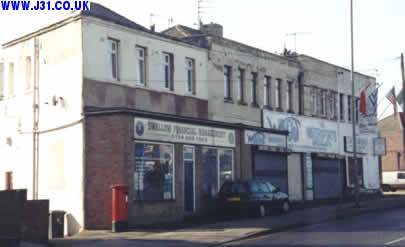
Left; was Lentons, centre; old Walker's Post Office, right; Eyre's grocers, Right; chip shop and Johnson's transport cafe
Next came the Park Hill Block of Shops. The first one, a double fronted emporium, was Lenton's Electrical, Radio and Cycle Shop, run by father and son. Many radios in those days needed lead acid accumulators and one steady trade was the recharging of these. My two most vivid memories was my first new cycle (round about 1948), a heavy Raleigh complete with dynohub lighting and three speed which sat in Lenton's window for a few weeks until my birthday (I met someone from the village only a few years ago who bought this from me in 1958 when I bought a motor scooter and I think that he said that he still had it ). The other great excitement was around 1950 when mysterious boxes with glass screens started to appear in the shop. Sutton Coldfield TV transmitter was due to open and it was rumoured that the signal should reach Swallownest. Lentons set up a small viewing room in their cellar to demonstrate the new fangled device to prospective customers (although I know of some people who used it as an alternative to the Pavilion Cinema on Millstone Hill and never got round to buying one of Lenton's sets !). On the day of the transmitter switch on, I was straight off the bus from Woodhouse Grammar School and into the shop. There in the cellar was a TV set, probably a ten inch screen, showing an old George Formby film. Unfortunately, despite my pestering, my parents didn't buy a set straight away - not surprising since the cheapest set, around £60, was the equivalent of about five or six weeks' wages.
Next door was the Post Office, run by Norman and Gladys Walker; the office had formerly been in Park Street (see below).
I got to know the Walkers and the office well since my first paid employment was to take out telegrams on a Saturday morning - using my new bike. I was paid half a crown (twelve and a half pence) which seemed a fortune since it doubled my pocket money. There was also money from tips, especially if you had a bundle of greetings telegrams to take to a local wedding reception. This was the first of several jobs for the Walkers; when I reached sixteen, along with many friends I joined the Christmas post delivery team, then on a couple of occasions during university vacations, stood in during the summer for each of the regular postpersons in the village. Standing in for Joe who was the full-time postman (the other two, ladies, were part-time) was quite a job since it involved use of the official cycle with parcel carrier, no three speed and even heavier than my own. To make matters worse, work started with sorting at the office (by this time moved to Millstone Hill), cycling to Aughton to start delivery, then cycling to Ulley to finish the round. In the afternoon, there had to be another Ulley visit to pick up the mail there for onward transmission to Sheffield via the Swallownest office. My last job was to act as stand-in postmaster for a couple of weeks whilst Norman and Gladys went on holiday but, on balance, I think I preferred postal delivery work.
Next door was Eyre's Grocer's and Greengrocer's Shop run by Jack and Mabel Eyre (she was of the Adsetts family - see below). For most of this period, rationing was in force and we were registered with the Co-op at Treeton where my father was manager but Jack and Mabel's was our local convenience store for non-rationed goods - bread, greengrocery, fish etc. - and I often spent my sweet coupons there. Visitors walking to our house in Chesterfield Road were often surprised in the summer by a loud, penetrating repetitive voice coming from the yard behind the shop. This was the Eyre's parrot whose only phrase appeared to be "Mabel, I'm absolutely fed up". No further comment !
The other two shops in order were a Fish and Chip Shop (very busy during the period of rationing) and Johnson's Transport Cafe. If I recall correctly, when the Johnsons gave up the business, it became rather more upmarket with a new lease of life as a steak bar.
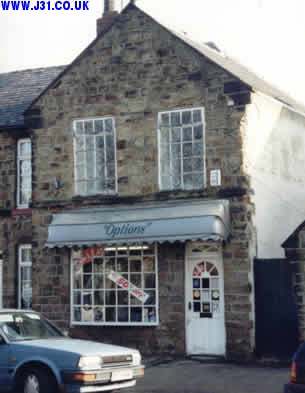
Anthony's beeroff
The first shop, next door to the Methodist Chapel was Anthony's which was a 'Beer-off' - to newcomers to South Yorkshire, an off-licence. Its juxtaposition to the Chapel was a little unfortunate, given that most of the congregation there were strict teetotallers. As well as selling bottled beer, draught beer could be purchased - just take your own jug or bottle. Mr Anthony would fill a standard measure via the tap on the barrel which stood in the corner, then transfer it to your container via a large copper funnel. Of course, we youngsters were confined to buying soft drinks or to supplementing our pocket money by returning any empties which we found lying around to claim the two penny deposit.
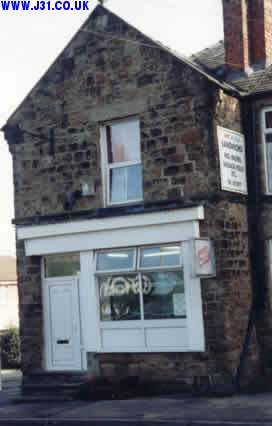
Cownleys
At the other end of the row, on the corner of Park Street, was a small General Grocers and Off-licence, run by Cownleys.
At the junction of High Street and Rotherham Road, on the opposite side to Swallownest School stood the premises of the man who, in my opinion, was one of the most enterprising in the parish, George Durham.
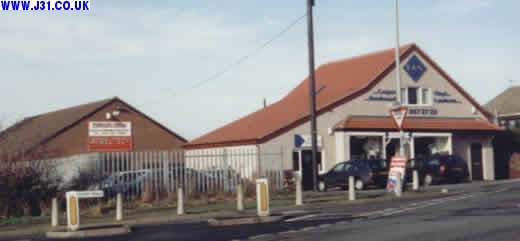
Durham's
His business had several arms - he had a shop which sold general hardware, paints, toys etc; he had an extensive Timber Yard; as well as stocking timber, he would build things such as rabbit hutches, hen houses, sheds and garages. He also ran a Taxi Service using a large Buick for weddings and the like. In the 1930's, he combined some of the above into a holiday enterprise; he obtained some land at Bridlington and, on it, built some chalets. These were very basic - paraffin stove for cooking, chemical toilet and twelve volt lighting provided by a car battery. The weekly rate for a chalet included transport in his car to Bridlington and return; amongst the luggage would be a freshly charged car battery to (hopefully) keep the lights going for another week. In modern terms, it all sounds rather basic but it should be remembered that many families found it difficult to afford a holiday at all and those who did often found themselves in boarding houses where you didn't have access to the house or your room during the day. So, to have a place of your own, however basic, could be seen as a distinct advantage. His nephew, my brother-in-law George Duckenfield, told me that he sold the chalets to a Bridlington man towards the end of the war.
George Durham also had an eye to demand. When toys were in short supply during the war, he made wooden ones. Two which I remember having as presents were a wooden model of an RAF bomber with a wing span of about one foot and a marvellous wooden machine gun; this had a handle which you turned and which then emitted a very realistic machine gun noise, much better than having to say "Bang, bang" during the frequent war games which we played.
Opposite George Durham's shop, on the corner of Nursery Road, was another General Grocer's, run by Bolsovers (no relation to the chemists - see below)
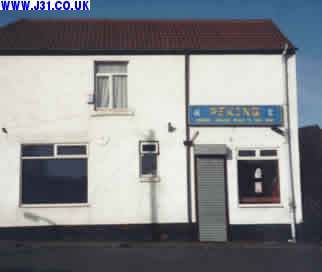
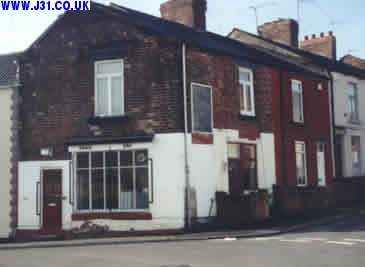
Beely's bakery and old Post Office on Park St.
Where Park street divides into two, there were two shops. The one on the corner on the right had been the Post Office until its transfer to Park Hill. The one opposite was Beeleys, a Bakery and Baker's Shop; the business was run by Cliff Beeley , eventually assisted by his son, Alan. They operated a bread delivery service around the parish and, for some time, were involved in the delivery of school meals from the central kitchens (near to the Miners' Welfare Hall) to some of the local schools. I can remember that the shop was a favourite calling-off place in my latter days at Swallownest School to buy a scone for eating during playtime with my free milk.
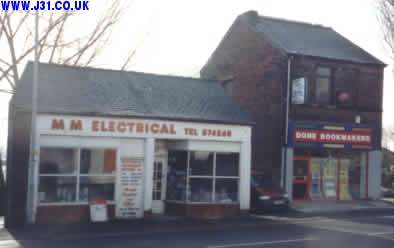
Single story building; haberdashery, two story; grocery store
Going down the steep part of Park Street by the post office, you reach Main Street and straight opposite is what was the Swallownest Branch of the Rotherham Co-operative Society. The biggest building nearest to the traffic lights was the Grocery Department, managed by a Mr Duckenfield; the small brick building to its right, set back from the road, was not part of the Co-op - it used to be the local mortuary ! "The Stores" as it was commonly known was the main shop in the parish, paying a very good dividend to its members (around 10%); every purchase was accompanied by a small tear-of slip showing the amount of purchase and, before the days of computers or even calculators, the manager had to spend a considerable time totting up the totals. Presumably, at the Head Office in Rotherham, teams of clerks had to go through the records and allocate sales to individual customers, according to their membership number. For those brought up in the era of self-service, the shop was very different. Like most co-ops of those days, there were polished wooden counters, a bacon and cheese counter with marble surface, everything came into the shop in bulk and had to be weighed out and bacon was sliced to order (type of bacon and thickness of rasher) on the bacon slicer. My father, who worked for Rotherham Co-op all his life (apart from three years in the army during WW1) started at the age of thirteen at Swallownest where, as was usual in those days, the then manager ruled the place with a rod of iron. A fellow 'apprentice' who became a lifelong friend was a bit of a rebel and not renowned for his time keeping. On the last occasion that he was late, the manager looked at his watch and asked "What time do you call this ?". After looking at the clock, the reply came back "Ten past bloody nine, what time do you call it ?". That was the end of his employment - no official warnings and industrial tribunals in those days.
Next door to the grocery department was the Haberdashery Department, managed by Miss Ball. This could provide all the requirements for sewing, knitting etc. and, if it wasn't in stock, could soon be obtained from Rotherham. It was the sort of very useful shop which was present in most villages and which has in many cases disappeared, necessitating trips to larger shopping centres for such supplies.
The third department was the Butcher's, manager Frank Turner who lived in Aston, opposite the end of Aughton Lane. I mention this because of an event which was one of my father's favourite stories. As I've already said, we were registered with Treeton Co-op for our groceries but it was more convenient to register with Swallownest Co-op for meat. On one particular Sunday, all my father's attempts to carve the small joint of beef failed - it was almost all fat and gristle. He was so annoyed that he put down the carving knife and cycled the mile or so to Frank's house at Aston and dumped the joint into his hand, telling him in no uncertain terms what he thought of it. When asked by Frank what he should do with it, my father declined to give the obvious reply but suggested that if he valued his dog, he wouldn't give it to him. I think that the quality of our meat did improve after that.
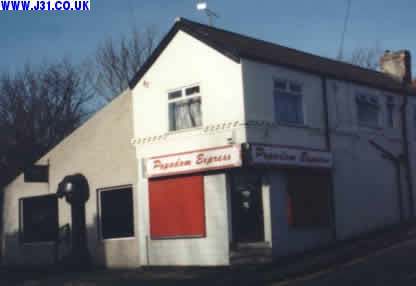
Schofield's 'farm shop' and wallpaper/paint shop
On the other side of Main Street, directly opposite the Co-op, was Schofield's. Mr Schofield had many talents - in addition to running these two shops, he had a Poultry Farm, a Market Garden (just below the Co-op on Main Street) and was also the Pastor of Bethesda (Assembly of God) on Mansfield Road. I think that he had been the driving force behind the building of this place of worship and, as I've pointed out to many of the current devotees of the evangelical worship trends in the Church of England, there's nothing new - Pastor Schofield introduced the 'happy-clappy' style over fifty years ago! Schofield's was, in fact, two separate shops. Entering by the door on the corner of Main Street and Park Street, you could buy the products of the poultry farm and market garden. The other door, just higher up Main Street took you into the Wallpaper and Paint Department
On the same side as Schofield's, at the junction with High Street, was Adsetts' which was a small corner Grocery Shop with a separate Off-licence just round the corner on High Street. The shop had for many years been run by the Skidmores and for long after they'd left, the bus timetables still referred to Skidmore's Corner. I can also recall that, at one stage when I was very young , part of the shop fronting Main Street was set up with a few tables and chairs and you could get ice cream and such things there. The shop and the adjoining terrace of houses was demolished some years ago and the site is now occupied by the Co-op Supermarket.
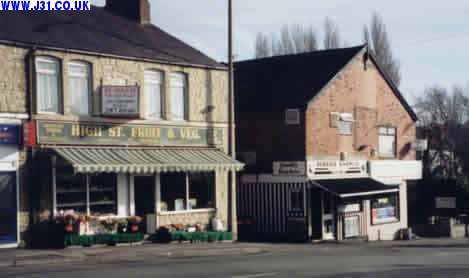
L - R; Harrison's butchers, Hallam's butchers, Wagstaff's chip shop, Prichards undertakers entrance
The first establishment was, and still is, the Undertakers, Charles Pritchard and Son. This was founded by my Uncle Charlie (really a relative by marriage via my mother's first husband) and carried on by his son Jim, then grandson Barry. Unfortunately, it is now Charles Pritchard in name only, have being swallowed up like most other independents by one of the large chains. In the days about which I'm writing, Uncle Charlie also did general joinery since the village was not large enough to support his business without this additional work. Uncle Charlie was a tall, imposing figure (and that was without his top hat worn at funerals). I remember Norman Walker saying to me one day that the one person he didn't like coming into the Post Office was him. "He stands there and asks for a book of stamps and all the time is looking me up and down and thinking 'I've just got a bit of oak that would suit you nicely' ". On another occasion he didn't appreciate my schoolboy sense of humour when, having received an annotated holiday postcard from my mother, I sent her back a similar one of Swallownest with Uncle Charlie's establishment labelled as "Uncle Charlie's Boxing Booth". She thought it funny but it didn't raise a smile with him.
Next door was Wagstaff's Fish and Chip Shop; whether it was true or not, it was often said that portions there were smaller than at other establishments. A joke which used to do the rounds was that a customer during the war, when you were expected to take your own newspaper, ordered fish and chips and was asked for his paper. Not having any, he produced an old fashioned bus ticket and told Mrs Wagstaff to use that but to ensure that the fish didn't fall through the hole punched by the conductor ! I can report that today when I visit the shop on my occasional visits to Swallownest, the portions are extremely generous. In the same block was a Butcher's, run by Mrs Maude Hallam.
In the next block was Harrison's Butcher's Shop. If I recall correctly, it was usually Mrs Harrison who served behind the counter and then, in later years, her son Norman took over the business. He and his wife bred Old English sheepdogs and I'm sure that the first dogs on the Dulux advertisements came from their kennels. Next door was Hall and Knight's, General Ironmongers; there you could buy your household hardware and, long before the advent of little plastic packets, your nails etc.by weight. I can remember little else about the shop except that the proprietor had a rather deep sepulchral voice - he could have been a good stand-in for Uncle Charlie.
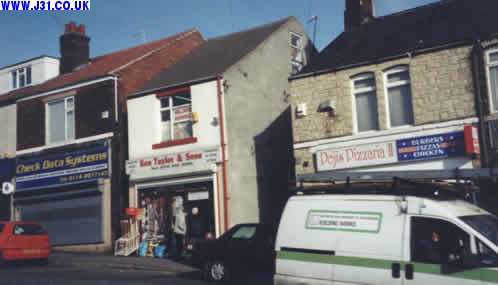
Left - Right; Bolsovers chemist, Hall & Knight, Parkin's
Bolsover's Chemist Shop was next; Mrs Bolsover was a smart, white-haired retired lady and I don't ever remember seeing her in the shop. This was staffed by Muriel Bolsover, her daughter, and Miss Simpson, a Scottish lady who worked there for years and who stayed on in the village, I think, after retirement. The shop had been started by Thomas Bolsover who had shops in Rotherham and who thought that the country air of Swallownest would be better for his family and so set up shop in High Street. If you ever visit the National Tramway Museum at Crich, near Matlock, look out for the stained glass display advertisements in the mock up of a tramway shelter in the Exhibition Hall. There you'll see publicity for Thomas Bolsover and his patent medicines - the glass came from the top opening windows on some of the old Rotherham trams. When I spotted these a few years ago, I was able to send some photographs to Muriel and later took her to Crich to see them. We had an interesting meeting with the Museum Manager and she was able to give him details of the family business.
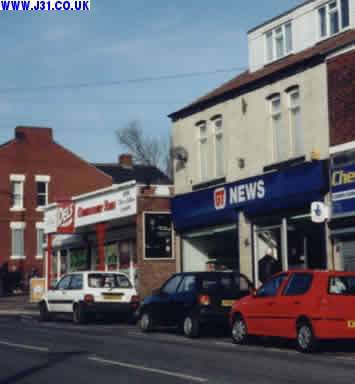
L - R; Harold Rose's grocery, Ellis's greengrocers, Goodwin's newsagents
The next two shops were Goodwin's Newsagents (formerly run by the James family) and Ellis's Greengrocers. I can say little about the former except the enjoyment after the war, when paper restrictions were relaxed, of being able to buy rather more comics (especially Radio Fun, Film Fun, The Wizard, Hotspur etc). We didn't really patronise Ellis's but one of his daughters was unpopular with young boys at Woodhouse Grammar School. As a prefect, she tried to insist, on threat of punishment, that we wore our caps all the way home. We preferred to wear them in our pockets. Mr Ellis, like Mr Schofield, was a leading light at a chapel - at Southall, the top end of Beighton; on Sundays, we often saw a group walking down Chesterfield Road to attend services there. Next to Ellis's was Parkin's which was another of the general grocery shops of the parish, all of which seemed to make a living, despite the competition.
The last shop was Harold Rose's Grocery Shop, formerly owned by his father-in-law, Mr Bates. Harold, like my father, had started out in life working for Rotherham Co-op but had decided to set up on his own and he used to tell my father that he should do the same. By that time, the Co-op grocery employees had negotiated very favourable employment terms including a five and a half day week (close at lunchtime on Saturday) and my father said that he preferred that to the 'open all hours' situation. Of course, given current opening hours, that would no longer be an argument. Harold had another role - he was organist and choirmaster at the Swallownest Methodist Church and so, given that establishment's views on alcohol (see above), I'm pretty sure that the shop didn't include an off-licence. Later, his son Haydn joined him in the business.
On the corner of High street and Queen's road was Asquith's Cobbler's Shop, housed in a small wooden hut. At the far end of Queen's road was a General Grocery Shop, run by Mr Mallender who was also a parish councillor. Being a businessman, he had a more realistic view of economics than many of his fellow councillors; it is reported that, in the early days of the Welfare State, one councillor was saying that the Government should pay for this and pay for that. He was put straight by Councillor Mallender - "Just remember that in this life, you can have 'owt for nowt, provided someone else pays for it". I'd suggest that never has a truer or more precise statement been made on the financing of the Welfare State !
Returning to High Street and continuing up it, the present Bank was there but under its original name of Williams Deacons.
At the top, what is now the optician's premises housed Bonsalls who ran a Plumbers and Plumbing Supplies business.
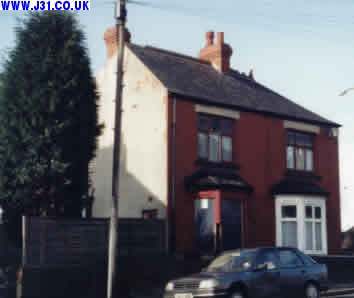
Haywood's hairdressers & barbers
Crossing over to the house where High Street joins Rotherham Road, you found the Haywoods. The part further from the school was a Ladies' Hairdresser, the part nearer to the school Walter Haywood's Barber's Shop. During the war, he was the only barber in Swallownest and so was always busy; I used to hate getting off the bus at Swallownest crossroads and then running up there to try to beat any fellow pupils to the queue. Although there were photographs of different styles around the shop, I reckon that everyone came out with the same cut, short back and sides. The final part of the ritual was the liberal application of setting lotion which we christened 'Stucko'; it set so hard that if you got out into the wind, your hair lifted in one solid sheet, rather like the lid of a pedal bin. The lotion was made from a powder mixed with water in a large bottle and required vigorous shaking for the mixing to be successful. This was done by Eric, who had I think suffered some brain damage (maybe at birth) but who was given useful employment by Walter. In addition to this and other duties, Eric also kept a swear book in which he noted the names (usually his own version) of the offenders and what they had said. When the wait got a bit tedious, Eric was always happy to read out some of his entries.
In School Street, there was a small Sweet Shop (in what had been the front room of a terrace house) run by the Brayshaws. I don't remember making any use of this during the period of sweet rationing but, towards the end of my time at Swallownest School, I remember it as a favourite calling off point to buy confectionery including aniseed balls and liquorice novelties. I also recall the shop selling something called liquorice root which looked like a twig but which, when chewed, gave the flavour of liquorice. My dictionary informs me that this is the source of the flavouring used in sweets although I suspect that, in this modern age, the flavour is a product of the chemical industry. There were also two unofficial businesses, based at the house of my uncle, Gerald Rayner. He was the caretaker at the School and, as a sideline, would charge your radio accumulator if you couldn't be bothered to walk to Lenton's (see above). His son, Kenneth, was a very talented photographer and his sideline was catering for weddings, christenings etc.
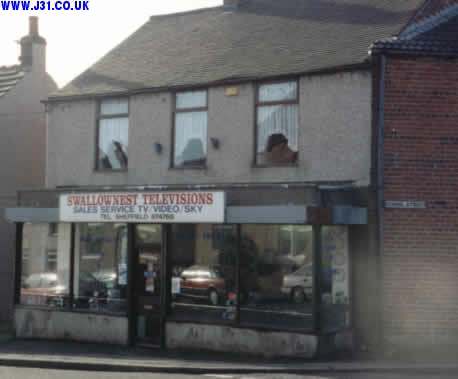
Ida Wombwell's wool shop
Returning to High Street, there were two more shops on this side. Just below School Street was Ida's - she sold, I think, some ladies' wear and wools etc. Lower down was the mecca of all children - Green's 'Emporium'; you name it, Nell Green sold it.
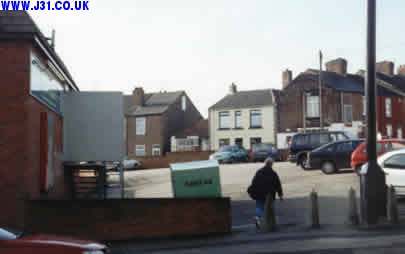
Site of Green's emporium (now the back entrance to the Co-op
The shop was housed in the front rooms of two adjacent terrace houses; it was very dark inside because the back of the small shop window was more or less covered in display boards (with a hinged portion to give access to the goods on display). The only outside light to enter was through a small fanlight over the wooden door - and that was partly blocked by a display of three large chamber pots in a pyramid arrangement, on a shelf over the door. When you entered, the shop bell gave a single loud ping and Nell would emerge from the back through a curtain. She always seemed to wear black and her hair was braided and coiled tightly round her head. The list of what was sold was endless - clothes pegs, polishes, toys, miners' snap tins and water bottles, buckets and of course chamber pots and, in later years, condoms ! When fireworks reappeared after the war, they were in short supply and you had to be there on a certain day and queue to get a fixed price bundle. My problem was that my mother couldn't go because she had gone back to teaching at Aston School but, fortunately, she was persuaded to let our daily help go and obtain the precious supplies; thanks to Lily ! In the early seventies when I had two small children, any visit to see my mother had to include a visit to Green's - it really was like a step back in time. I was devastated on the occasion when I drove up High Street to find that the whole terrace had been bulldozed.
At the corner of Aughton Road and Alexandra Road was another General Store, run by Joe Sharpe. He had also started his retail career working for Rotherham Co-op before branching out on his own. In later years, he worked for one of the insurance companies, travelling door to door to drum up new business and to collect premiums.
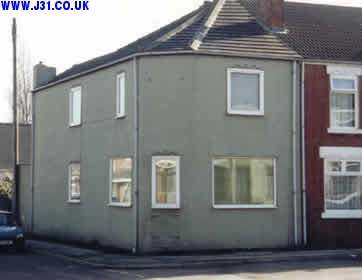
Robin's Newsagents
Down Alexandra Road was another Newsagent's, run by the Robins family, whose son John was a fellow pupil of mine at Woodhouse. Being surrounded by papers, he was always abreast of the news, local and national. Our physics teacher, Sam Barker, was a keen pigeon fancier and the racing results were usually reported in the Woodhouse Express. Sam's son was also a pupil at the School and one day, John said to him "I see your father came last in the pigeon races again". The priceless reply he received was "It wasn't my father, it was the bloody pigeons !"
Further up Aughton Road was yet another General Store, this one run by the Tysons. Mr Tyson somehow managed to combine this with being a full-time postman (he did have the advantage of a car, rather than using a bicycle) and also offered a taxi service.
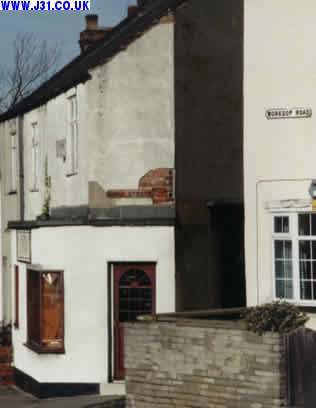
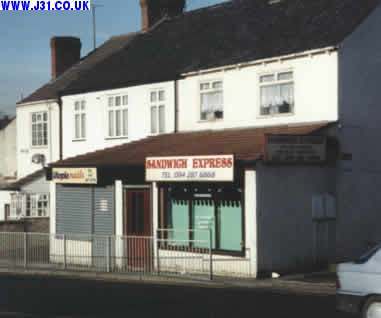
Albert Shaw's barber shop and Peat's drapery
The first small shop you came to, after Bradley's nursery, was Albert Shaw's Barber's Shop. This was closed during the war (I assume that Albert was called up) but it was a great relief when it reopened because the village's barbers' queues became shorter. In the next block, the first shop was Len Oldfield's Greengrocer's; he also has a horse and cart and toured round the village selling his produce (there was a rival who came I think from the Sheffield direction who was always known as Harry Hawker). Next, jutting out from the building line, was a large shop run by Mr Peat who sold clothes and drapery.
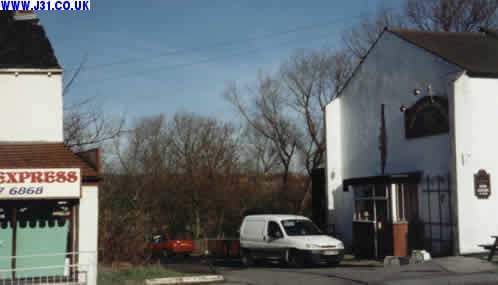
Billy Buch's garage site
Next door was the Billy Buck's Garage, Shop and Coal Merchant's Business. The shop, which had a couple of petrol pumps outside (vehicles had to stop in the road and the filler pipe from the pump was stretched over the pavement) stocked cycles and basic motor and cycle spares. Billy did car repairs and servicing and, at one time, gave lessons in basic maintenance to keen owners of cars and motor cycles. Further up the hill were two Public Houses, with a Fish and Chip Shop in between. The latter was quite small - you went down from the road into it and I remember a wooden form across the back of the shop so you could sit down if the wait was a long one. The proprietor was Mr Webster who, unfortunately, had a severe cast in one eye; hence when you were near to the front of the queue, it was not always clear whether he was talking to you or to the next person.
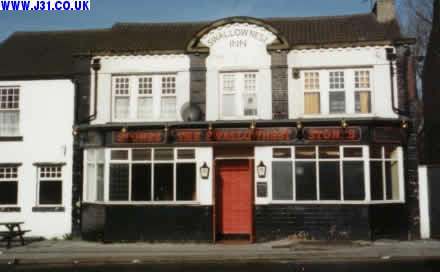
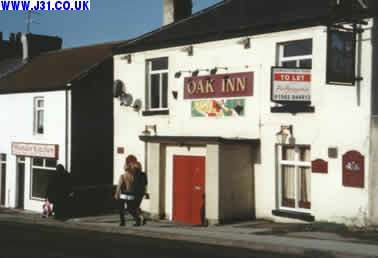
Siddall's (Swallownest Inn) and Clapham's (also Oak Inn or Maggie's)
The pub nearer to Peat's was the Swallownest Inn, usually referred to as Siddalls, the other one being the Oak Inn, or Claphams. I can't say that, when I was of legal age, or near enough to pass for eighteen, I used these establishments, any drinking usually being at the Blue Bell or Yellow Lion - often after my stint in the Church Choir on a Sunday evening ! It was, however, brought home to me on one occasion that Sunday lunchtime at Siddalls was in those days very much a male occasion. I'd come over from Cheshire for the weekend with my then girl friend and we called in Siddalls on our way home from the morning service at Aston Church. You could have cut the atmosphere with a knife from the moment we went in until we made our fairly rapid exit.
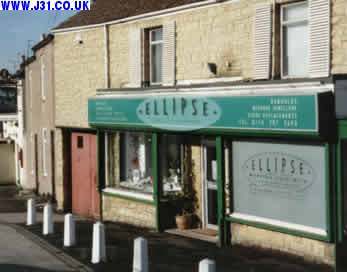
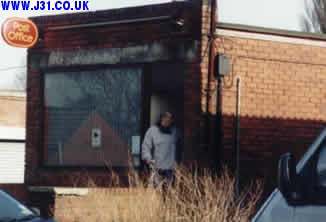
Keyworth's butchers and the Post Office
Past the two pubs, you came to Keyworth's Butcher's and then Manvers Road where there was, I think, another General Store on the corner. During the period covered by this account, the only shop on Manvers Road was the Post Office when it was re-sited from Park Hill (see above). The public part was somewhat smaller than it is now, the back part being the sorting office. Mail was delivered in bulk from Sheffield and then the local delivery staff had to sort it by hand before setting off on their rounds. In a rather safer environment than we have today, there were no armoured glass screens between counter staff and public - just a wire mesh. All the outgoing mail was also hand stamped - the dirtiest job of the day was changing the dates on the franking stamp. At the end of the day, any outward letters were put into a bag and then into the pillar box on the corner (the office had a key to this) for later collection by the van. However, one of my fellow Christmas temporaries lost the chance of future employment when, part-way round his Christmas Day delivery (yes, there really used to be one) and after the consumption of copious Christmas drinks, decided he'd had enough of deliveries and posted the remaining letters in his sack back into the nearest box.
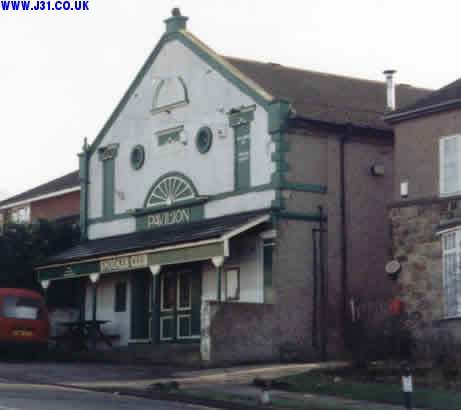
Pavillion cinema
Opposite Manvers Road was the centre of village entertainment - the Pavilion Cinema, now the snooker hall. This was managed by Alan Lax, seat prices ranging from about two new pence for the front seats (wooden, called the "chicken run") to about ten new pence for the stadium type 'balcony' where the seating arrangement guaranteed that you could see the screen rather than the back of someone's head. There were three changes of programme per week (four when Sunday opening started) plus a children's matinee on Saturday morning (known as "The Tuppenny Rush"). If you really wanted to impress your new girlfriend, you booked balcony seats (also guaranteeing the back row !) for an extra two pence. Unlike modern programmes, you really got your money's worth with main feature film, plus supporting film and newsreel/other shorts. The cinema was very long and narrow and I was intrigued when a showing in the new widescreen Cinemascope was advertised. I reckoned that if the screen was made any wider, there'd have to be a door in it to give access to the ladies' toilet. However, that didn't happen - Cinemascope at the Pavilion meant that the film simply occupied a narrow band in the centre of the existing screen - the effect we get these days with some television transmissions.
At the top of Millstone Hill, on the right hand side, in premises now occupied in part by the Co-operative Funeral Service, was a Butcher's and Greengrocer's Shop. The rest of Worksop Road up to Aston School was mainly houses except for Burnage Poultry Farm, where the Catholic Church is now sited. Opposite the end of Lodge Lane were three shops. . The first of these was a small brick built lockup in front of a house; this was Pashley's General Store.
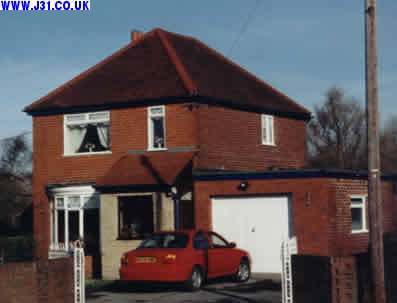
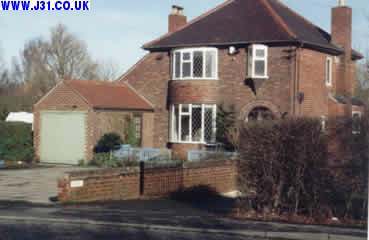
Site's of Pashey's and Killingsworth's
Next was Jack Killingsworth's Tailor's Shop, an extension built on to his house. Here, you could choose your cloth, either from the roll or from a pattern book and then Jack would produce a garment to your measurements.. In those days, there wasn't the range of fittings in off-the-peg clothes that there is today and so this service was more common (although most people would use the multiple tailors such as Burtons, Fifty Shilling Tailors etc in Rotherham or Sheffield). The problem with the small sample from the pattern book was that it was difficult to picture what the finished garment would look like and so you were sometimes in for a surprise. At a later stage, a wooden hut appeared next to Killingsworth's - this was a Newsagent's and sold Sunday papers. These days, you can buy these anywhere but, at the time, other newsagents in the Parish didn't; someone from Kiveton had operated a delivery service but, when that ceased, there were no scandal sheets to be had. Mind you, if you lived in Swallownest, Aughton or Fence, you really had to be keen to make the journey up there in order to read about the latest goings-on in the News of the World !
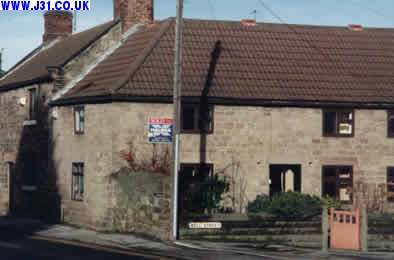
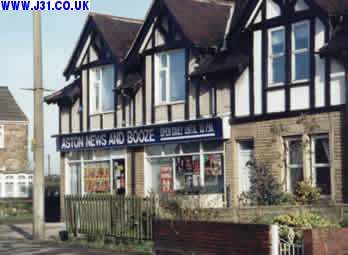
Old Aston Post Office site, Reg Marsh's and Marriott's
Continuing up into Aston, the shops at the end of Aughton Lane did not exist. In the cottage at the top of Bell Street, Mrs Duckenfield ran a small Post Office. The premises further along, now the newsagents, housed two shops. The first was Reg Marsh's Butcher's, the second Marriot's Grocers. As a small child, I was fascinated by the latter - I suppose its interior is the sort of thing you now see in folk museums. We didn't shop there but our next door neighbours in Chesterfield Road (the Duckenfields) did and I would sometime go with their daughter Mary. As well as the usual fittings as described above in the account of Swallownest Co-op, there were racks containing large biscuit tins with glass lids (again, no pre-packaging - you bought them loose by weight) and, on a high shelf, large pottery storage jars, each with its own label. Whether these were ever used or were just for decoration (with hindsight I suspect the latter), I don't know.
There were, of course, the two existing Public Houses, the Blue Bell and the Yellow Lion. Inside, both were very different from their present form with separate bars rather than the open plan arrangement. Upstairs at the Blue Bell was a large function room which was the usual venue for the annual dinner of Aston Hall Cricket Club. The Yellow Lion was much smaller than today; from the central front doorway, there were two rooms - if I remember rightly, the bar was in the one on the left, the one on the right being the lounge, complete with piano. This was played by a lady who's name I can't recall; I think that she played without music and her favourite tune appeared to be "Happy days are here again" - it certainly was played on a regular basis. In those days, the beer was from the Worksop Brewery - and very good stuff it was. On Christmas Eve, when we were in our late teens, a group of us used to go carol singing to raise money for charity - most of us were regular attenders at All Saints' Church. We visited various houses by arrangement, finishing off in the two pubs. By the time we were back in the Church Choir for the Midnight Service, our voices were in fine form (or, probably, so we thought !); one slight problem was that several of us had to be up again at about 5am to do our last delivery of the Christmas post.
Although I know little about any shops in this area, I must mention three people who stick in my memory. In a semi-detached house on the right hand side (coming from Worksop Road) lived Mark Sherriff who, with his sons Geoff and Ken, ran a painting and decorating business. His work was of a good standard, he was quick and charged prices that most people could afford. My father, having once attempted to apply wallpaper, always refused to do any more decorating - "I believe in every man to his trade" - so Mark was a regular visitor to our house. He used to bring all his equipment in a motor bike and sidecar until, in later years, he 'graduated' to an estate car. His particular speciality was 'graining' - making plane wood look like figured oak, ash or whatever you wanted. This involved the application of a matt coat of appropriate colour which was then 'figured' using various combs, brushes etc; when dry, coats of varnish were put on top for a gloss finish. This went out of fashion but it is interesting that in recent years, there have been TV advertisements for kits to do just this job.
Across the road, before you get to the new school, was Mr Bassender's site; he toured the parish with horse and cart selling bundles of sticks which he produced. It is reported that, on being asked what his job was, one of his relatives described him as a timber merchant ! For some reason, we children used to sing a song about him, the words of which went something like this:
"At the cross, at the cross, where old Bassey lost his
hoss
The wheels of his cart rolled away
It was eating currant buns when it heard the English guns
And the silly little bugger ran away"
The origins of this I don't know - any information would be
appreciated !
Finally, there was a Mr Barfoot who lived somewhere in the Seymour Road area; he was the Walter Haywood of the Aston end of the Parish. It was said that small boys were sometimes teased for having had a "Barfoot's Basin Crop" - but I don't think that he really used such a cutting guide ! However, he was ahead of his time since such cuts seem to be one of the current fashions - but costing a lot more than Mr Barfoot charged.
I'm sure that there are errors and omissions in this account; I'd be interested to hear other people's recollections.
Jon Layne, January 2001jon.layne@ntlworld.com
Copyright Jon Layne 2001, reproduced with permission